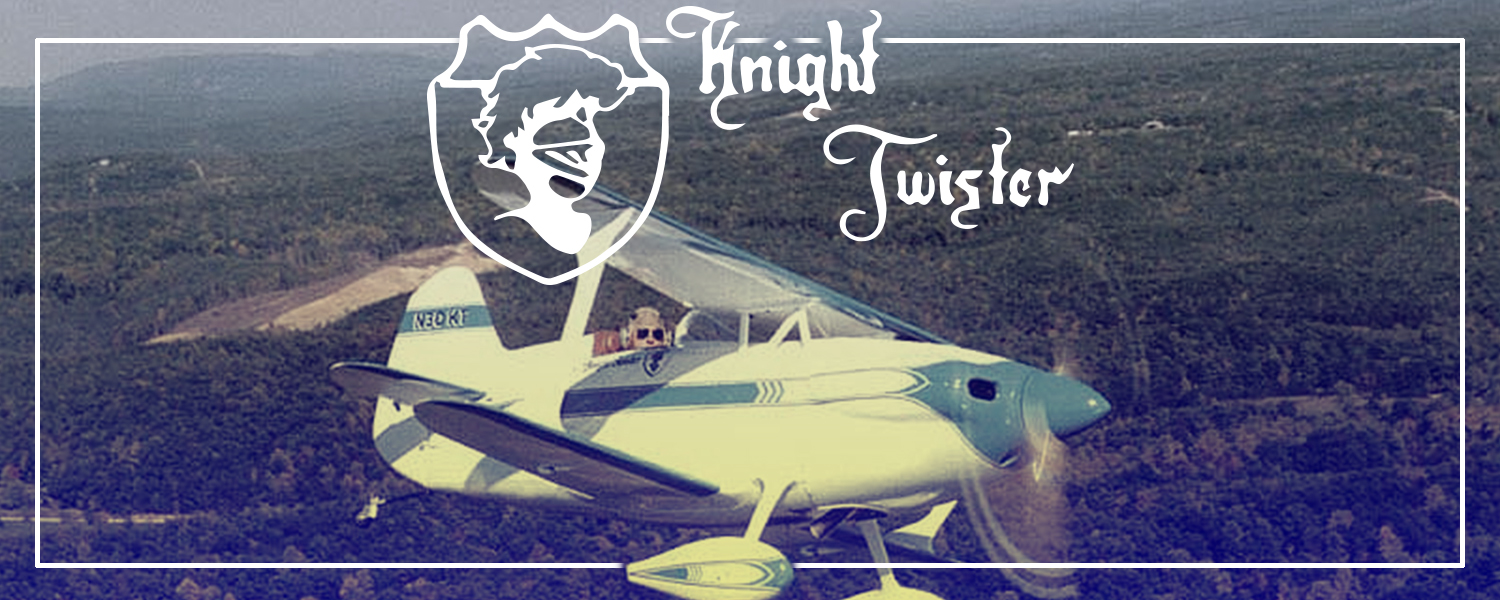
Knight Twister
Historical Information
The Knight Twister is the oldest aircraft design offered by Steen Aero Lab and has quite an interesting history dating back to the late 1920s. The fact that the design is still considered something special today is quite a testament to the plane and its designer, Vernon Payne. Born as a sketch on a chalkboard, the design has gone through at least eleven separate versions. You can learn a lot about an airplane by studying the story of its development, so sit back while we tell you how this wonderful little bipe came to be.
Humble Beginnings
In 1928, Vernon Payne was teaching students about woodworking, aircraft repair, and design and aerodynamics at the Aviation Service and Transport Company aircraft school in Chicago. In an effort to make the classes more interesting for the students, who were falling asleep from a dry dissertation, he changed the topic to minimum-sized sport airplanes. The students enjoyed the more exciting subject matter and were soon taking an active part in the discussions. By the time class was over, there was a rough sketch on the blackboard of a tiny biplane. This was the humble beginning of what would become the Knight Twister. Using NACA aerodynamic research reports, the class soon discovered the M-6 airfoil. Due to the M-6’s high L/D ratio (23) and stable center of pressure travel, he became very interested in it. Other reports provided information about wing shapes, taper, number of wings, etc. which Payne also used to keep his students interested. He and the students were surprised that so many designers of the time didn’t utilize the information from NACA’s research, and many seemed more interested in what competing designers had done.
Based on the NACA information, they used tapered wings with a combination of elliptical planform and negative rake. They knew that positive-stagger biplanes generally had slower landing speeds, so they used that layout. (They also liked the fact that it just looked faster.) They designed fully cantilever wings, but added a forward-leaning I-strut both for strength but also in part to make it look fast. Aerodynamically, the gap-to-chord ratio in the original Twister of 1929 was set fairly high, at 1.33 (gap of 34 inches divided by an average chord of 25.9 inches) and was increased in 1946 to 1.39 when the top wing was raised 2 inches for better visibility. Wing construction was mostly of plywood… it was too small for a built-up truss structure. Fuselage construction was conventional welded steel tubing, while the cantilever tail surfaces were wood.
They built a wing panel, and then statically tested it to the point of destruction. This showed the structure to be extremely strong. A fuselage was built and loaded up to design load, again with fine performance. Unfortunately, soon afterward came the great stock market crash of 1929, which soon put the school out of business. The parts of the plane they had built disappeared.
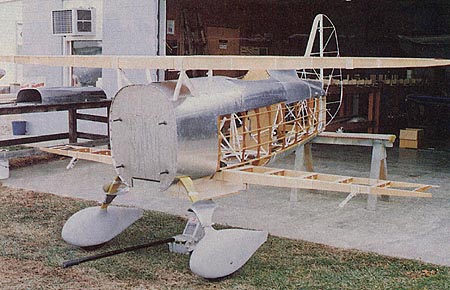
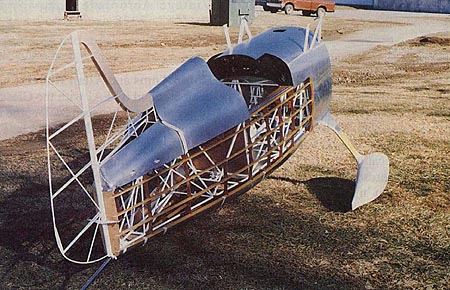
The Knight Twister Acro built by Hale Wallace of Steen Aero Lab, seen shortly before completion in 1998, gives a good idea of the construction methods employed. The design features steel tube construction for the fuselage, with wooden wings and horizontal tail surfaces.
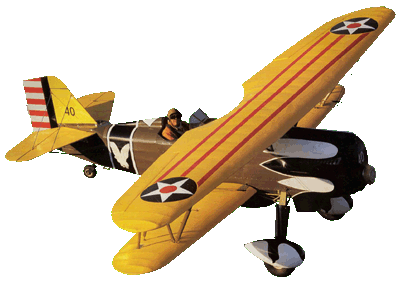
OK, you got us.. there definitely are similarities between the Curtiss P6-E Hawk (Don Sauser’s 82% replica shown) and the Knight Twister… but the designs are not actually related! We think it would be interesting to paint a Twister like a Hawk and see if anyone is fooled… (Budd Davisson photo)
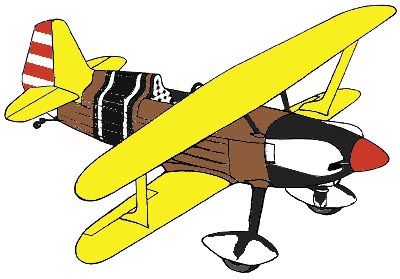
In 1931, Payne began working on the biplane again in the back of a garage. Popular Aviation magazine even got wind of the project and ran a series of construction articles, which brought forth an immediate positive response from it’s readers. The design had many practical aspects that appealed to builders. It was small, which eased the building arrangements for many. The longest tubing section in the fuselage was only five and a half feet long. This made it much easier for builders to scrounge up materials during the lean depression years. The wing was easy to build due to it’s cantilever construction that didn’t need external bracing, yet the fact that it was tapered and covered with plywood seemed to put off a few people. This perception that was so prevalent at the time is really responsible for the struts and flying wires, as the wings didn’t need external bracing to begin with.
First Flight
By the fall of 1932, the plane was ready to fly. It was powered by a used 7-cylinder Salmson AD9 radial engine producing about 45 horsepower, which was purchased for $350 – Payne wanted to put a NACA streamlined cowl on the plane, but didn’t have $10 to buy a used one!
The first Knight Twister was test-flown by “Curley” Cushman and was subsequently flown by many other pilots. They all felt that it was extremely stable for such a tiny aircraft. The plane flew just fine operating out of a small, slightly-uphill runway in a sod field. Landing speed was 45 mph, with the total weight at 550 lbs. Wing loading was 9.17 lbs./sq. ft. and the power loading was 12.2 lbs./hp. All in all, they were quite pleased with the little plane. Due to the small size, the rudder and elevator were right at cruise speeds but lost effectiveness when flying at landing speeds. The original six-foot-span horizontal surfaces were replaced with a seven-foot version, but this was too sensitive for cruise flight and the original was replaced and has been used since. The rudder was aerodynamically balanced at first, but after some experimentation the design settled upon surfaces about the original size but without the aerodynamic balance. Originally, the design used a “knee action shock system” landing gear, but as this provided poor ground handling, it was changed immediately.
Over the years, the Twister has gained a reputation of being quite sensitive on the controls, but this is really due to the fact that the well-balanced M-6 airfoil doesn’t require large control deflections to fly properly — yet most builders would use the same large control deflections required for most aircraft. The Twister is a thoroughbred, it will do anything you ask of it but it is a plane that responds beautifully to being flown smoothly, rather than being horsed around by a wildly-overcontrolling pilot. Vernon eventually redesigned the controls to allow for more stick travel but less control surface movement, in order to feel more natural to the pilot. It is indeed more sensitive than a Cessna, which can surprise inexperienced pilots at first, but they usually grow to love the perfectly balanced, “sports car” feel.
A Noble Name
Early on, the plane didn’t have a name. Payne was still teaching during the day and building planes at night, and most of his students worked night jobs as well. They would often complain about having to work nights, and Payne finally pointed out that even knights of old had to chase dragons and rescue damsels in distress during their spare time – and that rescuing damsels in the middle of the night was often very rewarding for the knight. This “knight’s work” soon lead to the plane taking on the moniker of the “Knight Work”. Later, a student noticed the plane wobbling during a test flight… which was determined to be due to the pilot (known only as “Frenchy”) sneezing repeatedly from a head cold, which made him cause the plane to porpoise. The student observed that “If they all fly it like Frenchy, it’s going to get all twisted.” Thus it became “Knight’s Twister”. The final name of “Knight Twister” is attributed to Mr. Rathbun of Popular Aviation magazine.
The plane’s debut for the press didn’t go so well. In a rush to clean the plane up after a dead-stick landing due to fuel exhaustion right before the big event, nobody remembered to put any gas in the plane. Curley Cushman ended up deadsticking into a muddy, rain-soaked golf course, tearing off the landing gear and cartwheeling the plane. This did end up proving the plane’s strength, however… Curley was alright, and the damage was mostly confined to the tail and the fuselage where the gear tore loose.
The Second Twister
The second Twister (the KTD-2) flew in 1935, custom built for a man from South America. It used the wings from the first airplane. The engine was an inverted four-cylinder Model A Ford conversion which was air cooled and produced about 70 hp. The engine was known as the Douglas Bear-Cat. This plane had an elliptical cross-section at the front of the fuselage to match the new engine (the original was round.) The plane was test-flown in Glenview, IL and sat in the hangar for months awaiting the arrival of it’s owner. He finally showed up, and for some reason refused to take delivery of the plane. The plane eventually passed through several hands and ended up in Columbus OH after WW2. Vernon Payne bought it and rebuilt it, adding a 2.5 foot center section to the upper and lower wings to get 73 sq. ft. of wing area. He added slots to the lower wing for better aileron control at high AOA, and changed the engine to a 75 hp Continental. The plane, now fourteen feet long and with a wingspan of 14 ft 0 in, became known as the Model 75-85 Knight Twister Junior. Unfortunately, Vernon’s son Richard Payne was killed during a test flight when the engine failed after takeoff due to a carburetor heat system problem. He tried to turn back to the runway, but the speed and altitude were too low, and the turn lead to a stall and crash that killed him on impact.
Later on, the design saw new developmental efforts. Though by his own admission, Vernon Payne was not much of a marketing person, the word did get out to an extent about the plane and it has enjoyed a fair amount of success over the years. It has been erroneously said that the Twister was a copy of the Curtiss Hawk or a Boeing biplane. Vernon Payne has emphatically stated that the design was not a copy, it was an all-original design. While the planes are admittedly quite similar in appearance, this is simply a coincidence. Perhaps Curtiss was paying attention to those NACA reports after all.
The Best Fighter the Germans Never Had
Before World War Two, Vernon was approached by the Nazi German government about the design. It seems that they were interested in a small airplane that could be carried by and launched from a submarine. They wanted to put it onto a single float and install a single 50-caliber machine gun firing through the crankshaft. Payne refused to help them or give them any useful information. History shows that they did in fact implement the idea. The Hansa-Brandenburg W-20 biplane appeared during WW1, the Caspar U-1 and U-2 and the LFG V 19 appeared about 1922, and the Focke-Achgelis Fa-330 Bachstelze towed gyro-glider was tried in WW2 (but met with little real success.) The Japanese were a little more successful, even managing to attack Oregon with a sub-launched airplane in a failed attempt to start a massive forest fire.
Gentlemen, Start Your Engines!
Clyde Parson’s Knight Twister (registered N67P) won the first two biplane races in Reno. In the first biplane race, held Sept. 14, 1964, his Twister won with a speed of 144.7 mph. This runaway success eventually led to a re-evaluation of the rules to allow other airplanes a better chance to compete. Vernon Payne himself suggested changes to the wing loading (under 12 lbs/sq. ft.) and wing area (at least 75 sq. ft.) rules, which actually ruled out Parson’s Twister… but the die had been cast. The Knight Twister was to become known as a serious racing aircraft.
Vernon met Don Fairbanks at the 1968 EAA convention in Rockford, who had just purchased a Twister project and was interested in racing. Their discussions lead to Don’s project becoming the prototype for a racing version. Vernon set out to redesign the wing to meet the new criteria, changing to a NACA 21 series airfoil. He lengthened the top wing from 15 to 17.5 feet and the bottom wing from 13 to 15.5 feet, and increased the chord by about 6 inches in order to be able to meet the 75 square-foot minimum for wing area. The stabilizer and elevators were lengthened to reduce high-speed porpoising, and the fuselage was lengthened by inserting a 9 inch section just forward of the cockpit, which increased pilot comfort as well as improved visibility over the wingtip while turning around the pylons. The fuselage has a laminar airfoil shape — 64-021 — when viewed from the top, with the wide part at the cockpit. Don used a Lycoming O-290-D2 engine developing 135 hp at 2700 rpm, which had to be mounted farther forward due to the fact that the pilot moved back. The fuselage was now two feet longer than the original. Flying wires were omitted as the wings were good for 7 G’s without them (and 9 G’s with wires.) 22.5 gallon and 12.4 gallon fuselage fuel tanks were installed, giving a good range – 480 miles in 3:15 with a one-hour reserve.
| KNIGHT TWISTER VERSIONS |
|
| ** denotes a Steen Aero Lab aircraft | |
Includes “official” versions for which there is published data. There are many homebuilt versions with significant modifications.
|
|
| Knight Twister version info compiled by Mike Whaley. Additional info courtesy Aerofiles and Steen Aero Lab’s KT Info Pack. | |
Vern christened the new version the Imperial, and Don’s N5DF first flew on June 19, 1970. After tweaking the horizontal stabilizer incidence, the plane flew very well. Gross weight was 1,125 lbs. It could fly at 150 mph TAS at 5500 ft. at 75% power, climb at 1,200 fpm., and it stalled at about 50 mph. Beginning in 1971, Don and N5DF made quite a name for themselves on the race circuit. Now on display at the Motorsports Hall of Fame and Museum in Novi, Michigan, the distinctively-painted airplane has won many races and set a world record for biplanes at 178.22 mph. This plane placed second at Reno in 1984, with a speed of 185.349 mph (the winner was a highly modified 150 hp Mong Sport that came in just a bit faster at 189.972 mph.) The Imperial model currently offered by Steen Aero Lab uses the M-6 airfoil.
Payne considered the Twister to be a sport airplane, not a dedicated racer, and was very proud that it was the only “real” sport plane in contention in the biplane class at Reno, and that it was still able to get into the winner’s circle.
The Twister is certainly a viable racing design, yet it’s also proved popular for just flying around and boring holes through the sky. Tony Sablar’s 1946 Twister with a “long nose” housing an 85 hp engine was a well-known fixture on the homebuilt scene for several decades (he didn’t even re-cover it until 1985.) The Knight Twister Acro pictured at the top of the index page, built by former Steen Aero Lab owner Hale Wallace, mirrored Tony’s paint scheme (except that Tony’s plane had red trim) and spurred much renewed interest when it first flew in the late 1990s.
He Said What About My Plane!?
In 1985, Vernon Payne wrote a letter in response to an article about the Knight Twister by the well-known homebuilt author, the late Peter Bowers. In the letter, Vernon took issue with some things and in the process, explained much of the design process and history. Read the letter here.
Information for this history was compiled from a variety of articles and essays by Vernon Payne, Hale Wallace, Don Fairbanks, and John W. Underwood.
